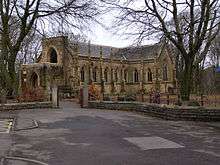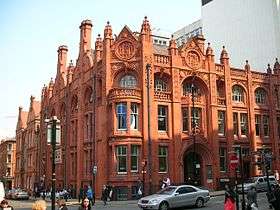Architectural terracotta





Architectural terracotta refers either to decorated ceramic elements such as antefixes and revetments, usually brightly painted, which made a large contribution to the appearance of temples and other buildings in the classical architecture of Europe, as well as in the Ancient Near East, or to forms of ceramic skins used to surface buildings from the 19th century onwards. In the latter sense unglazed architectural terracotta became fashionable as an architectural ceramic construction material in England in the 1860s, and in the United States in the 1870s. Glazed architectural terracotta was developed a little later. Both were generally used as a decorative skin to cover or supplement brick and tiles of similar colour in late Victorian buildings.
Terracotta had been used architecturally before this in Germany from 1824 by Karl Friedrich Schinkel. Edmund Sharpe designed and oversaw the construction of the first church built almost exclusively of the material, St Stephen and All Martyrs' Church, Lever Bridge in Bolton, erected 1842–45. Henry Cole, secretary to the Science and Arts Department of the UK adopted terracotta for the building which is now the Victoria and Albert Museum (1859–71) and then the Royal Albert Hall (1867–71), both in London. Alfred Waterhouse used it in his designs when in business in Manchester from 1853 and London from 1865. He used a combination of buff and blue-grey terracotta in his Natural History Museum in London. The colour of terracotta varies with the source of the clay. In Britain, London clay gives a pale pink or buff colour, whereas the Ruabon (North Wales) clay gives a bright red.
Terracotta had the advantage of being cheap and light. It was adaptable to mass-production techniques for stock shapes, although the plaster moulds had a limited capability for re-use. Additionally it could be freely worked by craftsmen to make custom-sculptured adornments and plaques. It was accepted as a material by the Arts and Crafts movement because despite seeming a mass-produced material it was handmade and designed by craftsmen. It had a manufacture time of about eight weeks and each piece had to be made over-size to allow for shrinkage as the clay body dried. To avoid cracking the pieces had to be quite thin. They were filled with concrete as they were applied to buildings.
The disadvantage of terracotta, apart from its rather uniform colour in a given district, was that it was not easy to keep clean. Town smoke made it blacken. A more modern phenomenon is the growth of naturally seeded plants and small trees which grow in the nooks and crannies of the intricate designs high above the streets now that the Victorian pollution has gone. Unglazed terracotta went out of fashion from around the 1890s, giving way to glazed architectural terra-cotta, or faience as it is known in Britain, which does not attract grime and is easy to clean, giving way to a more colourful architecture.
Glazed tiles had been widely used as a surfacing material before, especially in Islamic architecture, but architectural terracotta typically used relief or three-dimensional decoration in a way not normal with tiling, to achieve an effect similar to carved stone but with less effort and expense.
Manufacturers
- John Marriott Blashfield
- Burmantofts Pottery
- Fambrini & Daniels, Lincoln
- Gibbs and Canning Limited
- Gladding, McBean, California, USA
- Perth Amboy Terra Cotta Company of Perth Amboy, New Jersey, USA
- Boston Valley Terra Cotta, Buffalo, NY, USA
Bibliography
- Dillon M. (1985) Bricks, Tiles and Terracotta, An Exhibition on one of the major industries of the Wrexham area, (Held at the Grosvenor Museum, Chester), 24pp.
- James W P Campbell & Will Pryce, (2003) Brick: A World History,, ISBN 0-500-34195-8
- Stratton, M. (1993) The Terracotta Revival : Building Innovation and the Image of the Industrial City in Britain and North America. London : Gollancz.
| Wikimedia Commons has media related to Terracotta in architecture. |
External links
- Article on terracotta in Victorian and Edwardian Terracotta Buildings
- Understanding and Conserving Terracotta - Dr Michael Stratton
- Bolton Museums